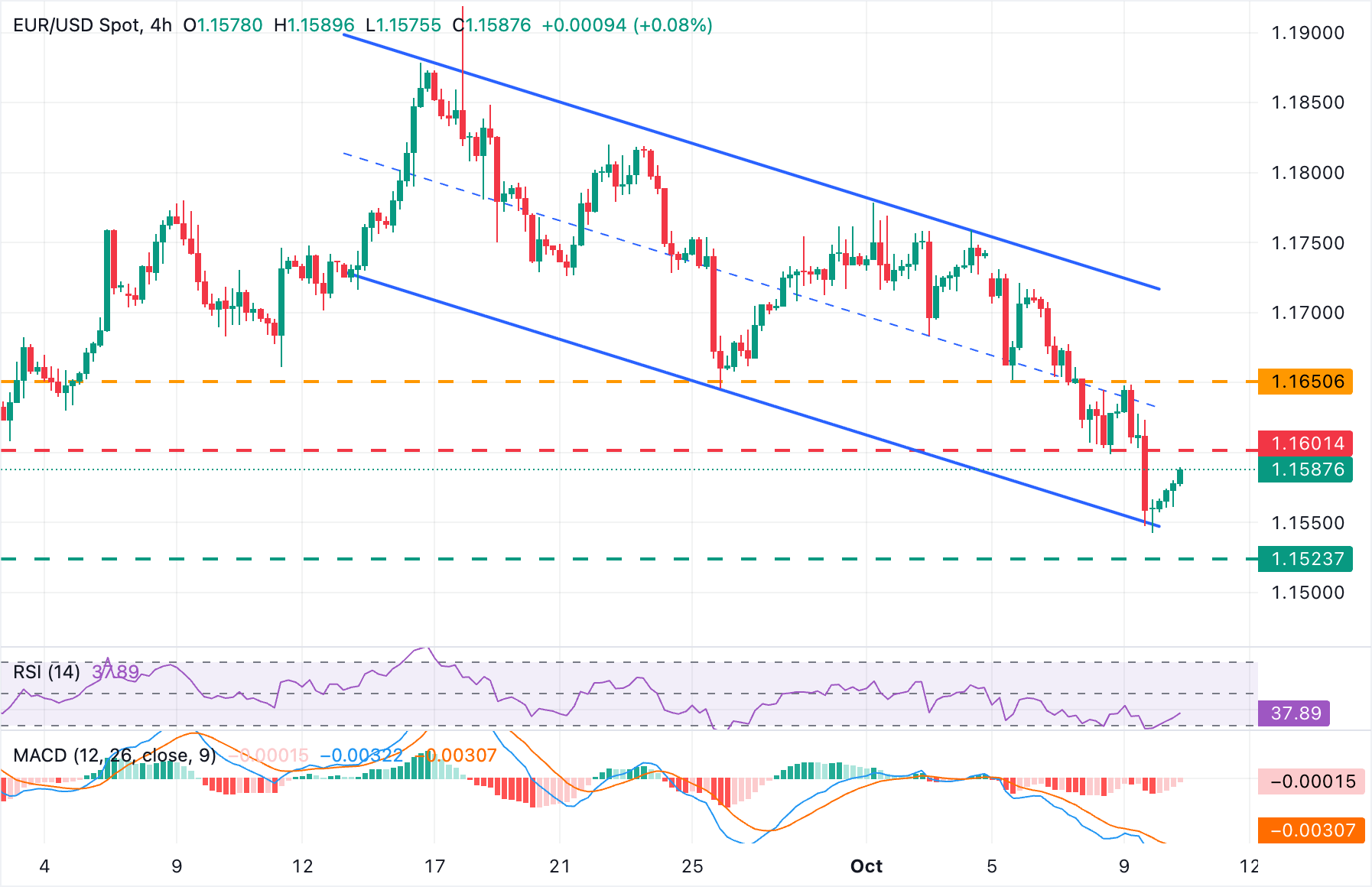Created
: 2025.10.10














![]() 2025.10.10 20:00
2025.10.10 20:00
In the absence of the US federal government's data releases due to the shutdown, the preliminary figures of its monthly Consumer Confidence Index, released by the University of Michigan (UoM), are expected to gain extraordinary relevance on Friday. This survey covers US consumers' views on their personal finances, business conditions, and purchasing plans, and is released together with the UoM Consumer Expectations Index and the UoM Consumer Inflation Expectations.
Consumption is a key contributor to the US Gross Domestic Product (GDP). In that sense, the UoM Consumer Sentiment Index, together with the Inflation Expectations, has a solid reputation as a forward-looking indicator for US economic trends, and its release tends to have a significant impact on US Dollar (USD) crosses.
Regarding October's preliminary reading, the UoM Consumer Sentiment is expected to reveal a further deterioration of consumers' confidence. The market consensus points to a decline to 54.2, from the 55.1 level seen in September
October's Consumer Sentiment report comes amid an economic data blackout from the US government, as the shutdown extends for a second week, and traders come to terms with the fact that, this time, it will be a prolonged one.
The release of the key Nonfarm Payrolls (NFP) employment report has been delayed sine die. Still, recent job data has added to evidence that the labour market keeps deteriorating fast. September's Automated Data Processing (ADP) Employment Change report shocked investors with the largest decline in net employment in more than two years. ADP reported a 32,000 drop in private payrolls, against market expectations of a 50,000 gain, and revised August's data to a 3,000 decline from the 54,000 increase previously estimated.
The Challenger Job Cuts, another employment gauge, revealed lower layoffs in September, but the report also stated that hiring plans by US businesses fell to their lowest levels in 16 years, confirming the trend shown by previous employment releases.
Pessimism about the job outlook was signalled as a major reason behind the deterioration of consumer sentiment in previous months, and the situation does not seem to have improved in the meantime. On the contrary, US President Donald Trump's vow of massive layoffs in the public sector, if government funding is not restored, threatens to further undermine labor market conditions.
Against this backdrop, Consumer Sentiment is expected to have extended its decline to a five-month low of 54.2 in October, from 55.1 in September. These numbers highlight a continuation of a downward spiral in US consumers' mindset, which would draw the Index to levels 25% below the average in the last quarter of 2024.

Source: University of Michigan
These figures are not particularly supportive for the US Dollar, but the negative impact on the Greenback is likely to be subdued this time due to safe-haven demand amid geopolitical and political uncertainties
The University of Michigan will release its Consumer Sentiment Index, together with the Consumer Inflation Expectations survey, on Friday at 14:00 GMT. The market expects the consumer sentiment to have deteriorated further in October. The negative impact on the US Dollar, however, is likely to be muted.
A quarter-point interest rate cut by the Federal Reserve in October is practically written in stone, and, from that point of view, Friday's reading is unlikely to dent the US Dollar's strength unless there is a sharp negative deviation from the market consensus. Investors' concerns about the consequences of a prolonged US shutdown and Euro weakness amid France's political uncertainty are likely to offset a potential decline in US consumer confidence,

Regarding the EUR/USD, Guillermo Alcalá, FX Analyst at FXStreet, sees the pair under pressure after breaching the support area near 1.1600: "EUR/USD broke a key support area at 1.1600 on Thursday, dropping to fresh two-month lows and highlighting the strong bearish momentum. Technical indicators are pointing lower, with the Relative Strength Index (RSI) on the 4-hour chart low but still above oversold levels. In these conditions, rallies look likely to attract sellers."
According to Alcalá, the pair needs to return above 1.1600 to avert further depreciation: "Failure to return above the 1.1600 level is likely to lead to a retest of the descending channel bottom, from mid-September highs, visible on the 4-hour chart, and Thursday's low near 1.1540. Further down, the August 5 low, near 1.1525, would be the last support area ahead of the August 1 low, near 1.1395.
The Michigan Consumer Sentiment Index, released on a monthly basis by the University of Michigan, is a survey gauging sentiment among consumers in the United States. The questions cover three broad areas: personal finances, business conditions and buying conditions. The data shows a picture of whether or not consumers are willing to spend money, a key factor as consumer spending is a major driver of the US economy. The University of Michigan survey has proven to be an accurate indicator of the future course of the US economy. The survey publishes a preliminary, mid-month reading and a final print at the end of the month. Generally, a high reading is bullish for the US Dollar (USD), while a low reading is bearish.
Read more.Next release: Fri Oct 10, 2025 14:00 (Prel)
Frequency: Monthly
Consensus: 54.2
Previous: 55.1
Source: University of Michigan
Consumer exuberance can translate into greater spending and faster economic growth, implying a stronger labor market and a potential pick-up in inflation, helping turn the Fed hawkish. This survey's popularity among analysts (mentioned more frequently than CB Consumer Confidence) is justified because the data here includes interviews conducted up to a day or two before the official release, making it a timely measure of consumer mood, but foremost because it gauges consumer attitudes on financial and income situations. Actual figures beating consensus tend to be USD bullish.
Tariffs are customs duties levied on certain merchandise imports or a category of products. Tariffs are designed to help local producers and manufacturers be more competitive in the market by providing a price advantage over similar goods that can be imported. Tariffs are widely used as tools of protectionism, along with trade barriers and import quotas.
Although tariffs and taxes both generate government revenue to fund public goods and services, they have several distinctions. Tariffs are prepaid at the port of entry, while taxes are paid at the time of purchase. Taxes are imposed on individual taxpayers and businesses, while tariffs are paid by importers.
There are two schools of thought among economists regarding the usage of tariffs. While some argue that tariffs are necessary to protect domestic industries and address trade imbalances, others see them as a harmful tool that could potentially drive prices higher over the long term and lead to a damaging trade war by encouraging tit-for-tat tariffs.
During the run-up to the presidential election in November 2024, Donald Trump made it clear that he intends to use tariffs to support the US economy and American producers. In 2024, Mexico, China and Canada accounted for 42% of total US imports. In this period, Mexico stood out as the top exporter with $466.6 billion, according to the US Census Bureau. Hence, Trump wants to focus on these three nations when imposing tariffs. He also plans to use the revenue generated through tariffs to lower personal income taxes.
![]()
Created
: 2025.10.10
![]()
Last updated
: 2025.10.10

FXStreet is a forex information website, delivering market analysis and news articles 24/7.
It features a number of articles contributed by well-known analysts, in addition to the ones by its editorial team.
Founded in 2000 by Francesc Riverola, a Spanish economist, it has grown to become a world-renowned information website.
We hope you find this article useful. Any comments or suggestions will be greatly appreciated.
We are also looking for writers with extensive experience in forex and crypto to join us.
please contact us at [email protected].
Disclaimer:
All information and content provided on this website is provided for informational purposes only and is not intended to solicit any investment. Although all efforts are made in order to ensure that the information is correct, no guarantee is provided for the accuracy of any content on this website. Any decision made shall be the responsibility of the investor and Myforex does not take any responsibility whatsoever regarding the use of any information provided herein.
The content provided on this website belongs to Myforex and, where stated, the relevant licensors. All rights are reserved by Myforex and the relevant licensors, and no content of this website, whether in full or in part, shall be copied or displayed elsewhere without the explicit written permission of the relevant copyright holder. If you wish to use any part of the content provided on this website, please ensure that you contact Myforex.
Myforex uses cookies to improve the convenience and functionality of this website. This website may include cookies not only by us but also by third parties (advertisers, log analysts, etc.) for the purpose of tracking the activities of users. Cookie policy